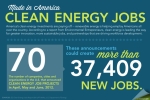1.80 per square foot
Commercial, Construction, State Government, Fed. Government
1/1/2006
12/31/2013
0.30-1.80 per square foot, depending on technology and amount of energy reduction
The federal Energy Policy Act of 2005 established a tax deduction for energy-efficient commercial buildings applicable to qualifying systems and buildings placed in service from January 1, 2006, through December 31, 2007. This deduction was subsequently extended through 2008, and then again through 2013 by Section 303 of the federal Energy Improvement and Extension Act of 2008 (H.R. 1424, Division B), enacted in October 2008. A tax deduction of $1.80 per square foot is available to owners of new or existing buildings who install (1) interior lighting; (2) building envelope, or (3) heating, cooling, ventilation, or hot water systems that reduce the building’s total energy and power cost by 50% or more in comparison to a building meeting minimum requirements set by ASHRAE Standard 90.1-2001. Energy savings must be calculated using qualified computer software approved by the IRS. Click here for the list of approved software. Deductions of $0.60 per square foot are available to owners of buildings in which individual lighting, building envelope, or heating and cooling systems meet target levels that would reasonably contribute to an overall building savings of 50% if additional systems were installed. The deductions are available primarily to building owners, although tenants may be eligible if they make construction expenditures. In the case of energy efficient systems installed on or in government property, tax deductions will be awarded to the person primarily responsible for the system's design. Deductions are taken in the year when construction is completed. The IRS released interim guidance (IRS Notice 2006-52) in June 2006 to establish a process to allow taxpayers to obtain a certification that the property satisfies the energy efficiency requirements contained in the statute. IRS Notice 2008-40 was issued in March of 2008 to further clarify the rules. NREL published a report (NREL/TP-550-40228) in February 2007 which provides guidelines for the modeling and inspection of energy savings required by the statute, and the US Department of Energy has compiled a list of qualified computer software for calculating commercial building energy and power cost savings. Click here for answers to frequently asked questions provided by the ''Commercial Building Tax Deduction Coalition.'' For more information on this deduction, visit the Energy Star web site.
Not specified, but building must be certified as meeting specific energy reduction targets as a result of improvements in interior lighting; building envelope; or heating, cooling, ventilation, or hot water systems.
http://www.dsireusa.org/incentives/incentive.cfm?Incentive_Code=US40F


